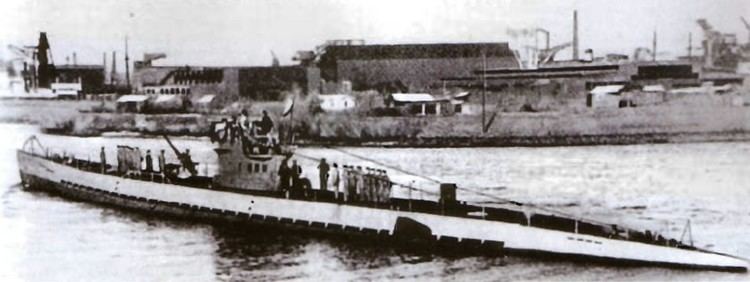Name U-64 Yard number 952 Commissioned 16 December 1939 Launched 20 September 1939 Draft 4.7 m | Ordered 16 July 1937 Laid down 15 December 1938 Construction started 15 December 1938 Length 76 m Beam 6.76 m | |
 | ||
Fate Sunk in April 1940 in Norway by a British aircraft; eight dead and 38 survivors | ||
German submarine U-64 was a Type IXB U-boat of Nazi Germany's Kriegsmarine during World War II. She was ordered by them in July 1937. Her keel was laid down by AG Weser in Bremen in December 1938. Following about nine months of construction, she was launched in September 1939 and formally commissioned into the Kriegsmarine in December.
Contents
U-64 had a very short career and sank no enemy vessels. Having left her home port of Wilhelmshaven for her first war patrol on 6 April 1940, she was intercepted by Allied aircraft seven days later off the coast of Norway during the invasion of that country and was sunk by a bomb from a Fairey Swordfish aircraft of HMS Warspite (03). Of her crew of 46, eight men died and 38 escaped from the sinking submarine.
Construction
U-64 was ordered by the Kriegsmarine on 16 July 1937 as part of Plan Z and in violation of the Treaty of Versailles. Her keel was laid down on 15 December 1938 by AG Weser in Bremen as yard number 952. She was launched on 20 September 1939 and commissioned on 16 December under the command of Kapitänleutnant Georg-Wilhelm Schulz.
Design
German Type IXB submarines were slightly larger than the original German Type IX submarines, later designated IXA. U-64 had a displacement of 1,051 tonnes (1,034 long tons) when at the surface and 1,178 tonnes (1,159 long tons) while submerged. The U-boat had a total length of 76.50 m (251 ft), a pressure hull length of 58.75 m (192 ft 9 in), a beam of 6.76 m (22 ft 2 in), a height of 9.60 m (31 ft 6 in), and a draught of 4.70 m (15 ft 5 in). The submarine was powered by two MAN M 9 V 40/46 supercharged four-stroke, nine-cylinder diesel engines producing a total of 4,400 metric horsepower (3,240 kW; 4,340 shp) for use while surfaced, two Siemens-Schuckert 2 GU 345/34 double-acting electric motors producing a total of 1,000 metric horsepower (740 kW; 990 shp) for use while submerged. She had two shafts and two 1.92 m (6 ft) propellers. The boat was capable of operating at depths of up to 230 metres (750 ft).
The submarine had a maximum surface speed of 18.2 knots (33.7 km/h; 20.9 mph) and a maximum submerged speed of 7.3 knots (13.5 km/h; 8.4 mph). When submerged, the boat could operate for 64 nautical miles (119 km; 74 mi) at 4 knots (7.4 km/h; 4.6 mph); when surfaced, she could travel 12,000 nautical miles (22,000 km; 14,000 mi) at 10 knots (19 km/h; 12 mph). U-64 was fitted with six 53.3 cm (21 in) torpedo tubes (four fitted at the bow and two at the stern), 22 torpedoes, one 10.5 cm (4.13 in) SK C/32 naval gun, 180 rounds, and a 3.7 cm (1.5 in) as well as a 2 cm (0.79 in) anti-aircraft gun. The boat had a complement of forty-eight.
Service history
U-64 went to sea on 6 April 1940. For eight days, she roamed the North Sea in search of Allied convoys heading to Norway in support of the campaign centred around that country. During that time she encountered no enemy vessels. On 13 April, the eighth day of her first patrol, she was heaved-to in the waters off Bjerkvik in Norway, and was struck by a 350-pound bomb from a British Fairey Swordfish aircraft of HMS Warspite (03). Her deck was also riddled with machine-gun fire. The U-boat then sank to the bottom of the harbor, eight of her crew went down with her. The remaining 38 were able to escape the sinking vessel and were picked up by German mountain troops stationed ashore. They later formed the crew of U-124.
